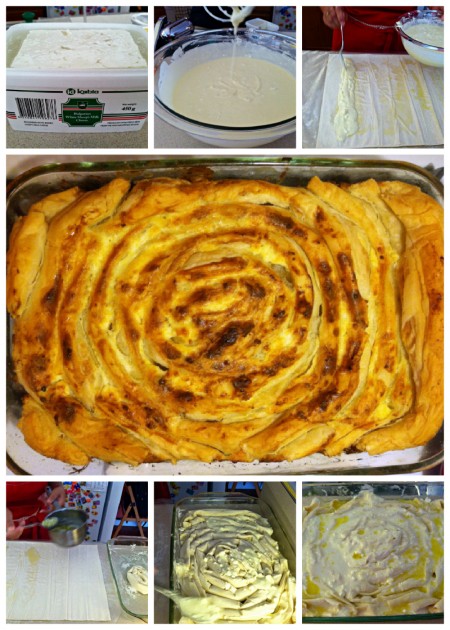Last New Year’s Day, my friend Elka invited me to watch her make banitsa, a phyllo-crusted pie—similar to a borek—that she grew up eating in Bulgaria. It’s an everyday food there, available with several fillings, but on Christmas and New Year’s banitsa holds special significance. As Elka explained it to me, during the 40-day Advent period religious Christians observe a vegan fast, eating nothing but plant-based foods. Come Christmas Day, cheese-filled banitsa leads the fast-breaking feast. And for New Year’s, many Bulgarians bake good luck messages into the pie, similar to the Greek vasilopita and the French galette des rois.
Elka worked without a recipe, combining and assembling: A mixture of yogurt, Bulgarian sirene (or feta) cheese, and eggs, thickened with flour and leavened with baking soda, is rolled inside individual, butter-brushed sheets of phyllo, then coiled into a baking dish. As Elka adjusted the filling, adding a pinch more flour, crumbling in a bit more cheese, she described her grandmother’s technique, which began with waking at 4AM to make the phyllo, stretching sheets across the kitchen until they achieved translucence. Elka’s version uses store-bought phyllo—her small Brooklyn kitchen doesn’t lend itself to painstakingly stretching dough—but her deliberate, almost ritualistic movements evoked earlier generations.
Once the spiraled dough filled the baking dish, Elka sprinkled seltzer on top—to keep it moist and fluffy, she said—and popped it into the oven. It emerged golden and crackling. I was tempted to grab a fork and dig in, but Elka insisted it needed some time to rest, to settle into itself. About twenty minutes later she handed me a serving, along with a squeeze-bear of honey to drizzle on top. And finally, a fork.
The crisp outer layer of phyllo, softened in spots by sticky honey, gave way to the still-warm, tangy filling. Though it was a substantial dish, eating banitsa gave me a feeling of lightness, thanks to the puffy crust and airy insides. I went back for seconds as soon as the last bite was gone, and although my banitsa didn’t yield a wish for the new year, I left Elka’s feeling quite fortunate indeed.
I took careful notes while Elka baked, and put together the following recipe for you. Feel free to use a little more of this, a little less of that—that’s Elka’s method, and it worked just fine.
Happy New Year!
Banitsa
Serves 6-8
1/4 cup + 2 tablespoons olive oil
1/3 cup all-purpose flour, plus more for dusting
3 eggs
2 cups plain whole milk yogurt
3/4 pound feta, rinsed
1/2 teaspoon baking soda
1/2 teaspoon salt, optional
500g phyllo (1 lb box—Elka prefers size #7, but if you can’t find it use whatever your market carries)
1/2 pound unsalted butter (2 sticks), melted
1/3 to1/2 cup seltzer
Honey, for serving
Preheat the oven to 350°F. Grease 2 pie plates with 1 tablespoon each of olive oil, then dust lightly with flour and set aside.
- In a large mixing bowl, beat the eggs lightly with a whisk, then add the yogurt and whisk until smooth. Crumble the feta into the bowl, then add the flour, baking soda, and optional salt (leave out if your feta is extremely salty). Stir together.
- Combine 1/4 cup of olive oil with the melted butter. Dust a clean work surface with flour, then unroll the phyllo. Lightly brush the top sheet with the butter and oil, then spoon 2 to 3 tablespoons of filling in a line along the short side.
- Roll into a cigar, and transfer to the first pie plate. Beginning in the center of the plate, form it into a spiral. Repeat with the next sheet of phyllo, continuing the spiral until it fill the plate, and then fill the second pie plate.
- You may have some filling left over—if you do, divide it over the top of the two pie plates. Drizzle with any remaining butter and oil, then with seltzer—don’t drench the banitsa, just moisten it.
- Bake for 45 minutes to an hour, until the banitsa is deep golden brown. Allow to cool slightly, then serve with honey.
MAKE BABY FOOD: The filling is wonderful for babies, and slightly older tots can handle phyllo—just be sure to give them small pieces, since crunchy bits can be surprisingly sharp. Do not give honey to children under 1 year old.


